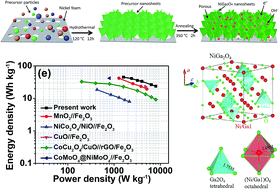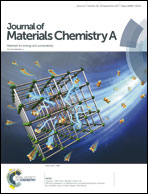An asymmetric supercapacitor with excellent cycling performance realized by hierarchical porous NiGa2O4 nanosheets†
Abstract
Rational design of the composition and electrochemically favorable structural configuration of electrode materials are highly required to develop high-performance supercapacitors. Here, we report our findings on the design of interconnected NiGa2O4 nanosheets as advanced cathode electrodes for supercapacitors. Rietveld refinement analysis demonstrates that the incorporation of Ga into NiO leads to a larger cubic lattice parameter that promotes faster charge-transfer kinetics, enabling significantly improved electrochemical performance. The NiGa2O4 electrode delivers a specific capacitance of 1508 F g−1 at a current density of 1 A g−1 with a capacitance retention of 63.7% at 20 A g−1, together with excellent cycling stability after 10 000 charge–discharge cycles (capacitance retention of 102.4%). An asymmetric supercapacitor device was assembled by using NiGa2O4 and Fe2O3 as cathode and anode electrodes, respectively. The ASC delivers a high energy density of 45.2 W h kg−1 at a power density of 1600 W kg−1 with exceptional cycling stability (94.3% cell capacitance retention after 10 000 cycles). These results suggest that NiGa2O4 can serve as a new class cathode material for advanced electrochemical energy storage applications.



 Please wait while we load your content...
Please wait while we load your content...